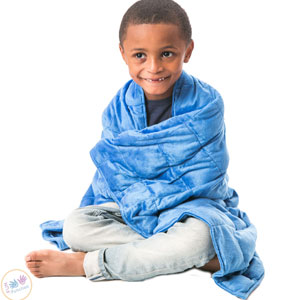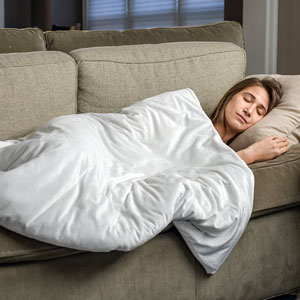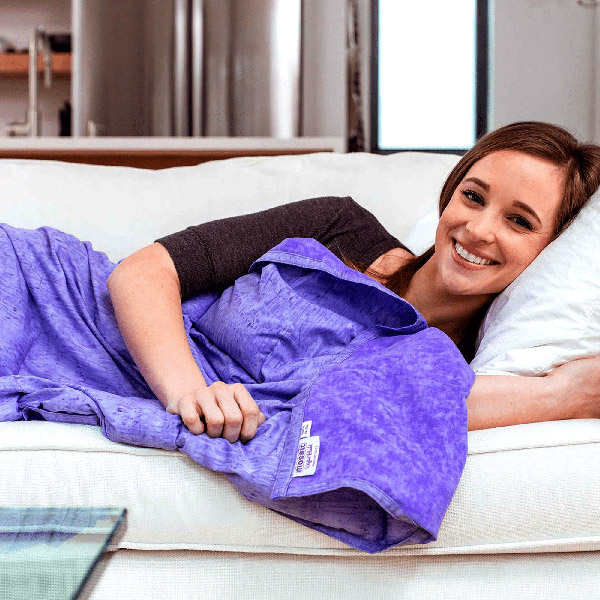What’s the Best Fabric for Weighted Blankets?
For transparency, I wanted to let you know that this page contains affiliate links. What is an affiliate link? In a nutshell, as an Amazon and Shareasale affiliate if you make a purchase after clicking a link on this site, I may receive a small commission, at absolutely no extra cost to you! Why do I have affiliate links on my site? Running a site like this and producing quality free content can be surprisingly time and resource intensive. Earning some affiliate income allows me to offset and justify the time and cost involved in producing content, paying for hosting, maintaining the site etc.
If you are considering a weighted product for yourself, a friend, family member or child: Please make sure you are well educated on the right weight to use, and whether use of a weighted product would be safe in your specific situation. If you are at all uncertain, please consult a qualified medical practitioner. Material provided on this site is for general informational purposes only and should not be considered a substitute for qualified medical advice (more info about that here).
If you’re serious about choosing a high quality yet affordable weighted blanket, and you don't know much about fabrics, read on.
After long hours of research, comparison, and analysis, I’ve come with a list of the most relevant weighted blanket fabric types and their pros and cons.
The next guide will give you some insight on all the different types of fabric you may find when buying a weighted blanket, and also if you want to choose the perfect fabric to use for a DIY comforter.
Read slowly, choose smartly, and invest in the best weighted quilt for you, or someone you care about.
Cotton
- Upgraded Design - Our weighted blanket will relax you by simulating the feeling of being held or...
- SIZE & WEIGHT: 48"x72" 15lbs, Suitable for 130-170lbs individual. Please choose the blanket that...
- MATERIAL: Comfort is a key ingredient of the YEMYHOM weighted blankets. Our blanket is made of 100%...
- WELL-MADE: With 10 Years of textile production experience, YEMYHOM carry out the highest standards...
- GIFT IDEA: Not only for sleeping at night, also for taking a nap, watching TV on couch. A MUST-HAVE...
As one of the most popular and widely used fibers worldwide, cotton is often used in weighted blankets’ manufacturing. There are conventional and organic types of cotton.
While weighted blankets made from organic cotton can be highly expensive, conventional variety is a lot more affordable.
The difference is conventional cotton can, in some rare cases, cause severe health problems -even going as far as cancer- because of its high content of chemical pesticides.
If you can’t afford organic, look for a mix of conventional and organic varieties. It isn’t something that usually happens, but it’s still good to know it.
Pros:
Cons:
Satin-cotton
- Lightweight blanket with 75% high-quality natural white down, recyclable and environmental-friendly....
- Box stitching prevent feathers from shifting. Beautiful satin weave shell makes the blanket more...
- Our blanket is filled with 12 oz. white down and feather
- Item size: 108"*90". The blanket will be packed in a brand-new factory sealed PVC bag
- All of our products follow the Responsible Down Standard and are certificated by OXIPOWER, TWICE AS...
If you suffer from heat sensitivities, I recommend you to try a satin-cotton cover for your weighted blanket. Some people like the tactile input of the satin as it helps them relax and treat mental disorders.
Satin-cotton is often combined with conventional cotton or minky to achieve the high quality on a minimal price.
Pros:
Cons:
Flannel
- Integration of Softness and Smoothness: Envelop yourself in a cloudy softness for a restful sleep...
- Why You Need a Weighted Blanket: Wemore weighted blanket wraps around you providing soothing...
- 7-Layer Design: Wemore weighted blanket applied safe and environmental ceramic beads filling in a...
- Choose Blanket: Choose the weighted blanket weighs about 8-10% of your body weight. It may take 2 to...
- Worry-free Warranty: We value our customers and take pride in providing heartfelt after-sales...
Unlike other weighted blanket fabrics – like fleece – flannel doesn’t get snagged on your bedding. This fabric has excellent breathability and will let your body breathe without sweating too much.
However, it’s best to use these comforters during the cold months due to their warm nature. Flannel also comes in a wide variety of thicknesses.
Pros:
Cons:
Here are some popular weighted blankets in different types of fabrics:
Image | Name | Fabric | Filler | Decorations | Prices & Details |
|---|---|---|---|---|---|
Moonbow | Bamboo and polyester | Micro Glass beads | 2 colors | ||
Fun and Function | Soft Plush cotton / polyester | Polypropylene pellets | 1 color | ||
Luxome | Ultra plush minky or luxury bamboo | Glass beads (certified lead free) | Many colours available | ||
Mosaic Weighted Blankets | Cotton, minky and textured fabric choices | FDA compliant plastic pellets | Widest range of colors and patterns |
Fleece
- Ideal Double Side: Wemore Sherpa Fleece weighted blanket features 220 GSM ultra-soft fleece top and...
- Calming Pressure: The weight from the blanket provides the right amount of pressure to make you feel...
- Wemore 7-Layered Smart Design: Our weighted blanket is centered with safe and environmental-friendly...
- The Size to Fit: Physiotherapists suggest choose a heavy blanket about 8% - 10% of your body weight....
- Satisfaction Guaranteed: We endeavor to provide the best quality products to our customers and value...
One of the biggest reasons why people choose fleece blankets is because of its cozy warm feeling. If you love wool fabric, but are sensitive to it, fleece is the perfect alternative.
There are several various types of fleece fabric like coral fleece, micro fleece, and polar fleece to consider.
Made from synthetic materials, fleece is lightweight, unlike wool. Plus, it’s affordable. However, if you have any texture sensitivities, it’s best to choose minky fabric.
Pros:
Cons:
Minky
- 1.PROFESSIONAL FACTORY FOR 15 YEARS - Daverose is a professional weighted blanket design and...
- 2.NEW GENERATION INTEGRATION - Daverose cares what you care, so all weighted blankets are made of...
- 3.PIONEERING SLEEP TECHNOLOGY - What we bring you is not only a blanket, but a big hug! Humans tend...
- 4.BEST AFTER-SALE 100% SATISFACTION GUARANTEE - No worries about the cleaning, use machine wash on a...
- 5.WE DO CARE YOU - We love you as our family, we want you to use the blanket safely by not covering...
Love those super soft baby blankets? The great news is, you can get a soft weighted quilt as well.
When it comes to blankets, minky is a star fabric that comes in a smooth, sleek, low-pile or a plush high-pile.
It’s usually 100% polyester and is considered the one of the best blanket fabrics worldwide.
Pros:
Cons:
Acrylic
Made from petroleum, acrylic can also be used for manufacturing weighted blankets. It’s slightly translucent and wavy and is a great alternative to cotton.
Despite having a synthetic construction, acrylic imitates the feeling of the natural fibers. Plus, it tends to be much cheaper than natural fibers.
Pros:
Cons:
Bamboo fabric
- The original YnM weighted blanket offers a natural way to help calm your body for a restful night of...
- YnM owns a unique 7-layer weighted blanket. Our 7-layer system is designed to contours to the shape...
- HIGHEST INDUSTRY STANDARD: 4.7”x4.7” smaller compartments for more evenly distribution + The...
- To choose a size for 1 adult, take 10% of your body weight, then add 1 lb; For sharing, please...
- COOLING & SILKY-SOFT BAMBOO FABRIC; not like the other cheap material, our YNM Bamboo Weighted...
Generally made of bamboo rayon, polyester, and organic cotton, bamboo fabric requires minimum cleaning and is quite durable.
Most importantly, it feels soft and soft like velour and is wallet-friendly. The biggest drawback is that bamboo quilts are boring due to a lack of printing options.
Pros:
Cons:
Chenille
- AS SEEN IN FORBES, WALL STREET JOURNAL, DR. OZ, COSMOPOLITAN, BULLETPROOF, LIFEHACK, SCARYMOMMY,...
- Sewn without visible stitching, giving The Magic Blanket a smooth, non-therapeutic look --- unlike...
- Design & Quality made by Professional Sewing Contractors with our Unique Elegant Plush Chenille...
Last but not the least, chenille is a fabulous fabric that ensures the softest hug any other weighted blanket fabric type can offer.
Unlike minky, chenille gives amazingly plush feel thanks to its longer fiber. It’s easy to wash and store, but pricey.
Pros:
Cons:
Here you have it some of the most popular weighted blanket fabric types to consider. Of course, there are many others and especially combos of several fabrics. Choose the blanket that will make you feel better and won’t drain your family budget.












